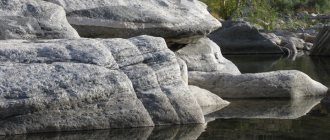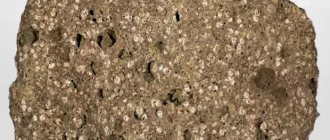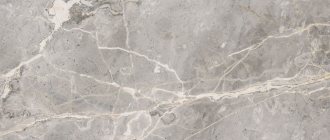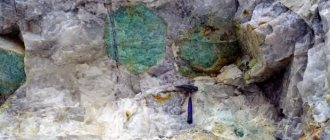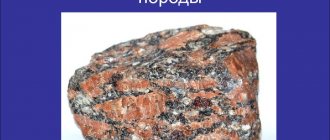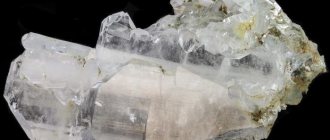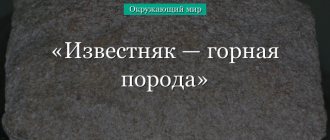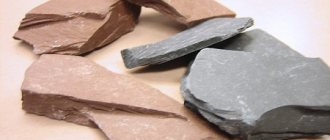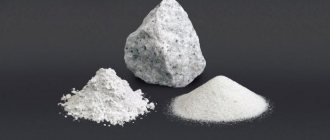Rock is a non-renewable natural resource used in many areas of human life. Houses and structures are built from stones, monuments, decorative slabs and coverings are made. They are used in jewelry, sculpture, architecture and painting. An entire industry was created in order to extract these amazing formations from the depths of the Earth. Based on physical and chemical properties and appearance, you can easily select a material to implement a specific task.
Origin of minerals
Minerals are homogeneous natural bodies that are chemical compounds of a certain composition. They have a crystalline structure, were formed as a result of geological processes and are considered components of rocks. There are three versions of the origin of minerals:
- magmatic;
- metamorphic;
- exogenous.
Solid materials can form due to the solidification and crystallization of magma. This alloy includes silicates, as well as almost all chemical elements. Some volatile substances get into the cracks of crystallizing rocks. They transform them, so different types of ores are formed: tungsten, tin, molybdenum. And when the temperature drops, deposits of copper, gold, lead, zinc, silver and tin are formed.
During metamorphic processes, minerals are formed under the influence of temperature and pressure. This phenomenon is associated with a change in the biological situation. During regional metamorphism, significant areas at depth are affected. And as a result of the contact process, magma affects the thickness of limestone.
Exogenous processes are based on solar energy. They occur at low temperatures and normal pressure near the earth's surface. At the same time, rocks exposed or lying at shallow depths are weathered, washed away by water and destroyed by living organisms.
Accepted classification
Geologists are still studying some minerals and figuring out what they are. Based on their work, several types of solid materials can be distinguished. They are divided according to their structure and chemical properties:
- silicates;
- carbonates;
- oxides and hydroxides;
- sulfides and sulfates;
- halides;
- phosphates;
- tungstates;
- native elements.
The class of silicates includes salts of silicic acids. They are part of any rock. It is the most abundant type of mineral on Earth. Carbonates are salts of carbonic acid. The most famous of them: calcide, magnesite, dolomite. Oxides and hydroxides are so called because of their chemical structure. These minerals are compounds of hydroxyl groups and oxygen. These include quartz and hematite.
Sulfides contain sulfur , and sulfates contain salts and its acids. The first group includes pyrite and cinnabar, and the second group includes gypsum and anhydride. Halides and phosphates are salts of halide and phosphoric acid, respectively. The first class includes sylvite and fluorite, and the second class includes apatite and phosphorite. Tungstates are salts of tungstic acid. The definition of native elements is also related to their properties. These are minerals that include only one component: gold, diamond, sulfur.
Basic properties
All minerals have their own chemical and physical properties. This is worth talking about in a report about rocks and their elements. Physical properties include fragility, causticity, brittleness and flexibility. One of the most important indicators for minerals is hardness. Talc is considered the softest, and diamond is the most durable.
These properties of minerals also include cleavage, fracture and tarnish. The first concept means the ability of a material to split along the crystalline direction. Tarnish is the presence of a thin colored film on the surface; it is formed through oxidation. And fractures are formed upon impact.
Minerals also have optical properties:
- color;
- shade of a trait;
- magnetic properties.
For some materials the color may be uniform, for others it is variable. Some minerals undergo many modifications. That is, they contain impurities, or they change color depending on the lighting. The color of the streak appears when scratched. This is exactly the shade the mineral takes on when it is ground into powder. Reflectivity is the shine that a luminous flux creates. Expensive varieties of minerals sparkle under the sun's rays. Materials that contain divalent iron have magnetic properties.
Areas of use
Today man has learned to use more than 15% of known minerals. They are mainly used in industry. The area of their use most often depends on the physical properties:
- abrasive and anti-abrasive materials are made from hard materials;
- quartz is necessary for the radio-electronic industry;
- Mica has been shown to have electrical insulating properties.
Talc is used in medicine and lubricants are made from it. Asbestos mixtures have long been used in construction; they are a good heat insulator. And fluorite, due to its properties, is used in optics. All minerals are divided into ore and non-ore. From the former, metal elements can be extracted, and from the latter, non-metallic raw materials for medicine, chemistry or construction.
Stones are also used in jewelry. In this case, they are divided by value. The most expensive jewelry is considered to be diamond, pearl, pyrite. And the cheapest ones are onyx, obsidian, alabaster. The latter are also called ornamental.
This is interesting: When is International Sun Day celebrated?
Large enterprises
The extraction of natural raw materials is carried out by mining enterprises, which are an independent production unit. They carry out exploration, extraction and enrichment of various rocks.
There are the following enterprises for the extraction of raw materials:
- mine;
- mine;
- career
- mine.
Modern mines and pits are represented by complexes of buildings grouped into blocks. On the surface there are buildings for lifting machines, overpasses, electrical substation premises and much more that may be needed when extracting natural raw materials. Material warehouses for various purposes are located on the surface.
In Russia
In the depths of Russia there are up to 10 thousand tons of gold and other raw materials, which have been mined for many decades. Industrial development is carried out at the Natalka field and Sukhoi Log. The Far Eastern District accounts for the majority of gold production - more than 50% per year.
List of the main Russian mining enterprises.
- "Alrosa". Located in the Sakha Republic. The main direction is diamond mining.
- Artel "Amur". Specializes in the mining of platinum and palladium.
- "Atomredmetzoloto" The company mines uranium ores.
- "Evrazruda". Engaged in the development of five iron ore deposits.
- Priargunskoye PGHO. Specialization - development of uranium and molybdenum-uranium deposits in the Trans-Baikal Territory.
This is only a small part of the enterprises operating in the domestic territory. Some of them are actively engaged in mining, but there are also those that are on the verge of bankruptcy.
Minerals
Minerals are native, stable chemical elements with unique physical and chemical characteristics. They are formed as a result of complex natural processes. And now humanity has learned to grow them in laboratories, on sea farms and factories. Minerals form rocks.
One example of how a person uses knowledge about minerals for his own needs is the artificial production of pearls. On special marine farms, conditions are created that are as close to natural as possible. The pearls obtained in this way are in no way inferior to natural ones and have similar characteristics.
Rice. 1. Diamond in the Rough
Several forms of minerals occur in nature:
- hard (gold, diamond);
- liquid (mercury, oil);
- gaseous (hydrogen sulfide, carbon dioxide).
Solid minerals, in turn, can be crystalline (quartz) and amorphous (all types of resins, opal). Crystalline minerals are based on numerous crystals, while amorphous minerals do not have them in their composition.
The properties of minerals largely depend on their structure. Thus, the same element is capable of forming different forms of minerals. For example, carbon can create two completely different compounds, with opposite properties: soft and plastic graphite and the hardest mineral in the world - diamond.
TOP 3 articles that are read along with this
Rice. 2. Diamond is the hardest mineral in the world
Age
Scientists and geologists determine the age of rock minerals using two scales.
Relative
The age of rocks is determined relative to each other: some are younger, some are older.
This is determined by stratigraphic or paleontological methods:
- The stratigraphic method involves studying the relative position of layers. But only if no movement due to tectonic processes has been observed over millions of years. That is, there was no destruction of the layers, their sequence was preserved. In this case, the higher the layer, the younger the rock. In the very top layers she is the youngest.
- The marker of the paleontological method is fossil organic remains. It has been established that coeval layers contain remains of the same plant or animal species.
Both methods take as a basis the location of rock layers in the earth's crust.
Absolute
The exact age of the deposits is determined by the state of the radioactive elements in the composition.
The degree of decay of radioactive elements is known precisely; it has a constant rate that is not affected by external disasters. This makes it possible to determine the age of the rock with an accuracy of hundreds of years.
Commonly used are uranium-235 or 238, thorium-232, and carbon-14.
The choice of isotope depends on the expected age of the rock:
- For material younger than 50 thousand years (for example, peat), this is an isotope of carbon.
- Isotopes of uranium, lead, thorium, potassium, and samarium are suitable for rocks older than 3.5 billion years.
- Rubidium-strontium, uranium-lead material is applicable to samples aged from one hundred million to five billion years.
To determine age, the ratio of the mass of the newly formed element to the mass of the radioactive isotope used is calculated.
Place of Birth
Rocks are the basis of the earth's crust, almost all of their deposits are of industrial importance.
They are classified according to several criteria:
- Type of raw materials. Ore, non-metallic, combustible (hydrocarbons, shale, coal, peat), hydromineral (water).
- Geological structure. Simple, complex, especially complex. The basis is the condition of the layers and the uniformity of occurrence.
- Depth. Depending on it, raw materials are extracted in an open (quarry) or closed (mine) way.
Production volumes are measured in millions of tons, and the price is almost always set per ton. The exception is radioactive and decorative materials. For example, Carrara marble.
How to mine
Mining is carried out everywhere. With the development of technology, this process has become somewhat simplified, but still remains dependent on the depth of the substance and its content in the rock.
Today there are three main methods of extracting raw materials:
- quarry - applicable only when the substance occurs shallowly;
- mine - allows you to mine rock of a higher grade;
- underground leaching method - a system of wells is used into which a special chemical reagent is pumped.
Loose, loose rocks, such as clay, sand, marl, are broken up by excavators and hydromechanically, that is, the rock is washed away with water and transported through pipelines.
Properties and characteristics
Each rock is endowed with characteristics and properties that create its unique description. Among the main ones are structure and texture.
The structure is created by granularity (shape and dimensions of grains), crystallinity, and the ratio of components:
- For igneous materials, the degree of crystallinity is taken into account.
- For sedimentary material, the shape of the crystals is relevant.
- Metamorphic agglomerates are classified according to grain size.
- Metasomatic formations are endowed with a granoblastic structure.
Texture is the relative arrangement and distribution of components in a volume:
- Igneous ones can be homogeneous or heterogeneous.
- In sedimentary materials, a distinction is made between the nature of the surface and the interlayer nature.
- Metamorphic rock formations are represented by spotted, banded, slate, flattened, and other textures.
- In metasomatic rocks, it is inherited from the original components or created in the form of rhythmic layers.
The texture reflects the layering, porosity, massiveness, colors, and shades of the rock.
This is interesting: Environmental problems begin with us
Main Differences
It is not always clear to people who do not understand geology how rocks differ from minerals. Although both groups of materials are naturally occurring compounds, there are differences between them. Both minerals and rocks are part of the earth's crust and are of great interest to science.
Minerals are native, stable chemical elements with unique properties. They are formed as a result of complex natural processes. But today people have learned to grow them themselves in laboratories, marine factories and farms. Rocks are composed of one or more minerals. That is why they may have the same names, but one rock may contain a variety of minerals.
The main difference between the two concepts is heterogeneity. If minerals are built on the basis of a crystal lattice, then rocks consist of microparticles that are connected in a chaotic manner. That is, such material does not have a single structure.
The earth's crust is made up of many minerals and rocks. They have different origins, physical and chemical properties. And man has long learned not only to extract and use them in various fields, but also to grow minerals on his own.
The natural power of gems
- Aventurine is a symbol of love and happiness. Such minerals of pink, green or brown color will allow a person to reveal his creative abilities.
- Ruby is a stone for leadership. It gives its owner additional energy.
- Turquoise is a stone of luck and victory. He has unusual abilities that allow him to suppress feelings of anger and irritation towards people.
- Malachite is an ideal amulet for children. It will protect them from danger and the manifestation of disease.
- Lapis lazuli is a heavenly stone that imparts kindness and peace to its owner.
Why do you need to study the properties of rocks?
Identifying the properties of rocks is of practical importance:
- Low porosity makes the agglomerate stronger and denser. It is less vulnerable to moisture, but conducts heat and current worse. The situation is similar with graininess.
- Acoustic parameters depend on elasticity.
- Magnetic and electrical characteristics affect electromagnetic properties.
When developing a deposit, the volume of deposits plus the nature of the raw materials are taken into account: hardness, density, integrity, degree of weathering. Based on this, they select equipment, determine the quantity, composition of the team, and the time to complete the work.
The exact physical and technical characteristics of the rock help to develop the optimal technology for their use.
For builders, the massiveness, strength, and abrasion properties of the rock are important. Decorators prioritize beauty and processing capabilities.
Quartz
Quartz is the most common mineral in nature. It is part of many rocks. The share of quartz in the total mass of the earth's crust is about 60%. Chemical formula of the mineral: SiO2.
The name “quartz” comes from a German word and translates as “hard.” In its pure form, it is a fairly hard, colorless (or whitish) mineral. Impurities of other substances can give it a wide variety of colors. There are several dozen varieties of quartz (flint, amethyst, chalcedony, onyx and others).
Choosing the right stone
When choosing a talisman for yourself, astrologers recommend relying on zodiac signs, date, and month of birth. Choosing a talisman is somewhat easier. To do this, you need to determine what you should protect yourself from.
Read also: The first traffic light appeared in London, and it was two-color
The most powerful amulets are those given by loving people from the heart. Also good are those talismans that were literally given by fate or appeared in life under strange circumstances.
List of the most common rocks used by humans
Rocks, depending on their composition, method of formation, chemical characteristics and structure, are divided into classes and groups, which include individual minerals. It is difficult to describe all rocks. Some classes include from several dozen to hundreds of different elements.
The table shows a list of the most popular and widespread natural resources.
| Class | general characteristics | Group | Name |
| Silicates | Contains silicon and silicic acid salts. | Feldspars |
|
| Mica |
| ||
| Clayey |
| ||
| Soap |
| ||
| Chrysotile |
| ||
| Carbonates | These are minerals containing carbonic acid salts. | Calcite |
|
| Basic |
| ||
| Oxides | Found in all types of rocks. Contain oxides of various substances. | Quartz |
|
| Chalcedony |
| ||
| Hydroxides | Sedimentary rocks. | Limonite |
|
| Opal |
| ||
| Sulfides | Compounds of metals with sulfur and non-metals. | Pyrite |
|
| Sulfates | Salts of sulfuric acid. | Gypsum |
|
Many rocks are composed of elements belonging to different groups of fossils.
The most interesting of them:
- Granite. Contains mica, quartz and feldspars.
- Sandstone. It is formed from fragments of various rocks, which are cemented by various minerals.
- Slate. They are characterized by a layered structure formed by the compression of several rocks.
Interesting Facts
There are many rocks that are mined from the bowels of the earth. All of them allow you to get things necessary for a comfortable life, make it possible to heat your home, eat, make decorations and much more.
Facts about minerals that allow you to learn more about the secrets hidden in the underground depths:
- Coal is a common fossil that is often used as fuel. It is interesting that from a layer of peat 20 meters under pressure, a coal layer of only 2 meters is formed. The lower the layer of dead vegetation lies, the thinner the coal seam will be.
- Malachite is a semi-precious stone that is often used by jewelers. The largest mass mined weighed 1.5 tons. Such a treasure was presented to Empress Catherine II, and later the mineral became the property of the Museum of the Mining Institute in St. Petersburg.
- Gold has been awarded the title of one of the most flexible metals. It is even used to make sewing threads. One ounce of gold can produce a thread about 80 km long.
- Obsidian is a volcanic glass with a high density. The mineral is formed under the influence of very high temperatures during the eruption of magma. Archaeologists have found confirmation that the first surgical instruments were made from obsidian.
Due to their diversity, minerals are used in medicine, jewelry, everyday life and much more, making human life and activities easier.
Feldspars
Is feldspar a mineral or a rock? Many are sure that it is the second. In fact, it is a mineral, and one of the most common. It belongs to the class of silicates.
Feldspars are the main city-forming minerals of many rocks of igneous origin (for example, granites). Today they are widely used by people: in the glass, ceramic, and chemical industries. They are also used as fluxes in metallurgy and as fillers in toothpastes.
LITHOTHERAPY IN EVERYDAY LIFE
Many people come into contact with the elements of lithotherapy these days, even those who have never heard of it. For example, in modern cosmetology, tools made from natural stones are widely used - this is a lymphatic drainage roller for the face and gouache.
Rosary beads with stringed beads made of stones can be found in the attributes of many religions - Hinduism, Islam, Christianity and Buddhism. They are used to count prayers read and for concentration. Rosary beads can also be seen on people who do not consider themselves to be members of these religions: it is believed that rosary beads can help when thinking about the right decision. In addition, when working with rosaries, fine motor skills of the fingers develop and joints are healed.
Particular attention is paid to the meaning and powers of gems when choosing jewelry. Lithotherapists are often contacted to choose “their” stone, taking into account the request of the future owner, his character and astrological compatibility. The action of the selected mineral can be aimed at strengthening human protection, correcting and harmonizing his condition.
Properties of the most popular stones:
- Rose quartz has a cleansing effect, improves emotional stability, and increases self-esteem.
- Sodalite is a symbol of meditation, calms the mind, promotes healthy sleep, fights anxiety, removes redness on the skin, and brightens it.
- Black obsidian - repels negative energy, stimulates blood circulation, its energy has a detoxifying effect.
- Amethyst - helps cope with addictions, eliminates internal aggression, and has a cooling effect.
- Onyx is a stone of leadership, helps to cultivate internal discipline, and restores the owner’s energy.

